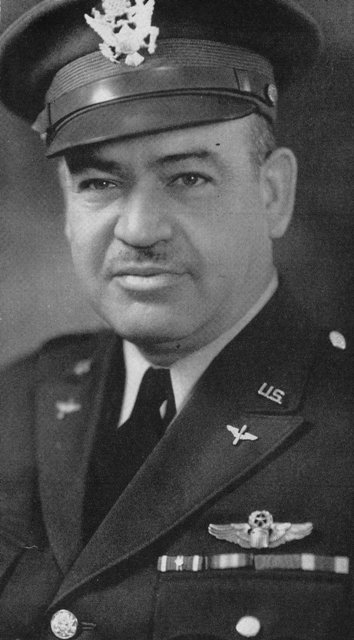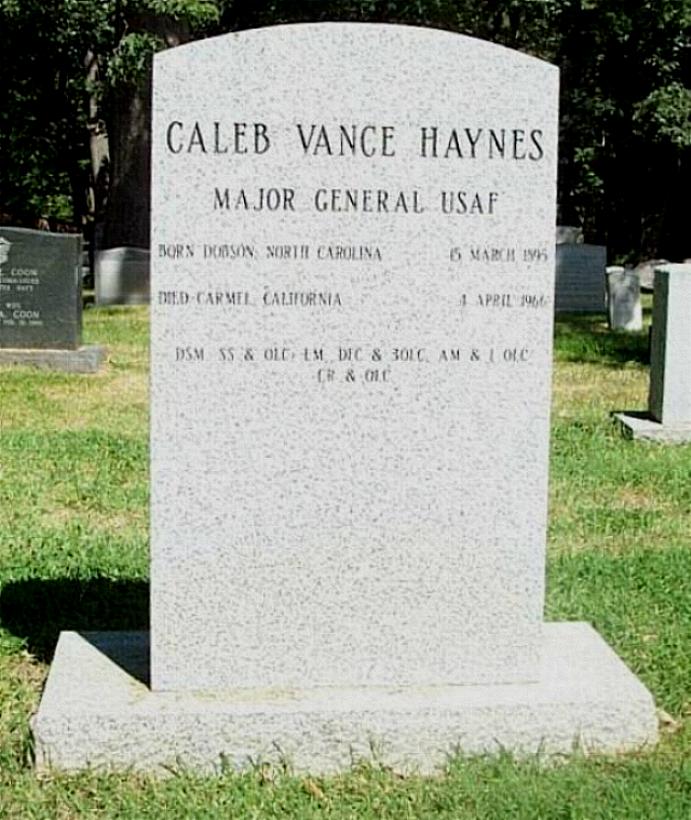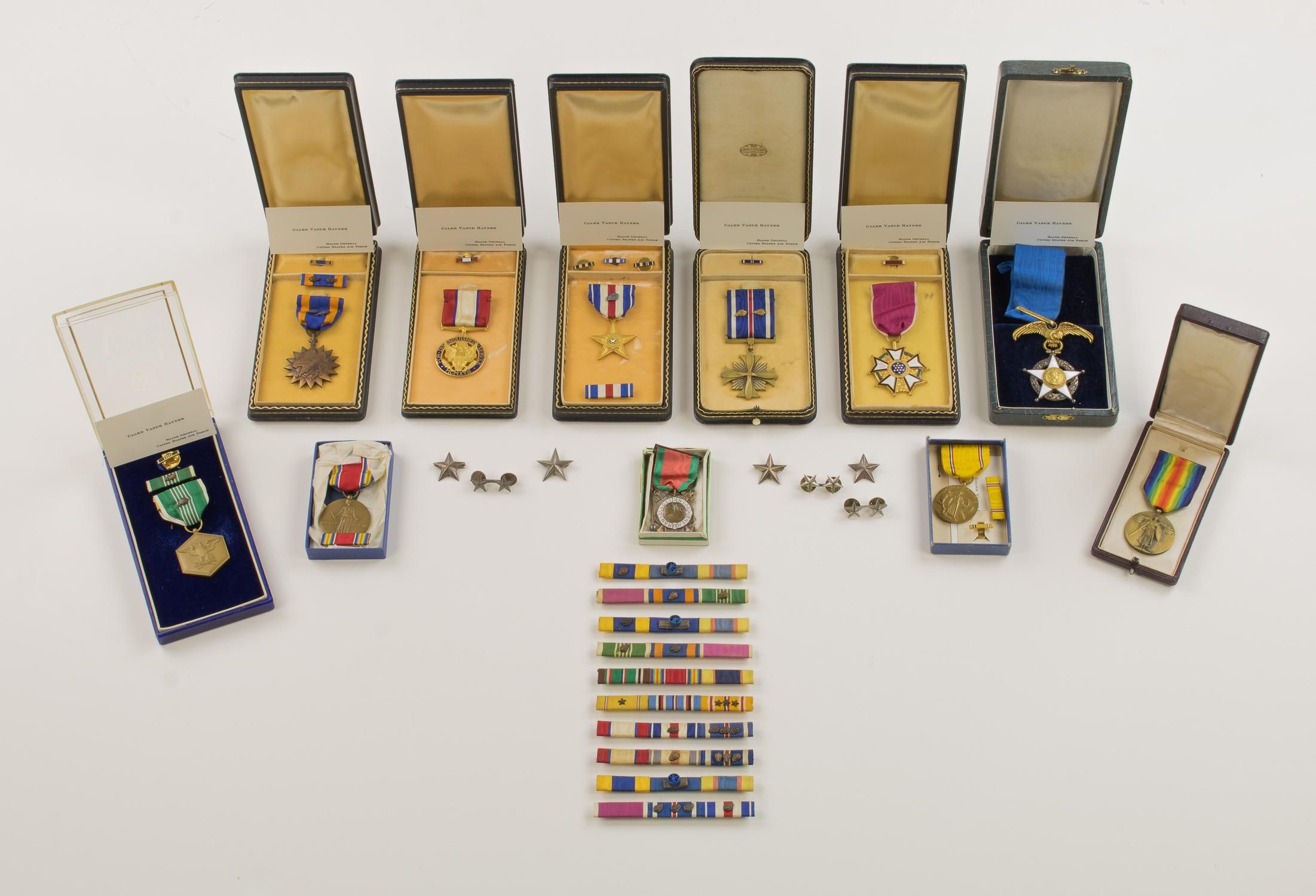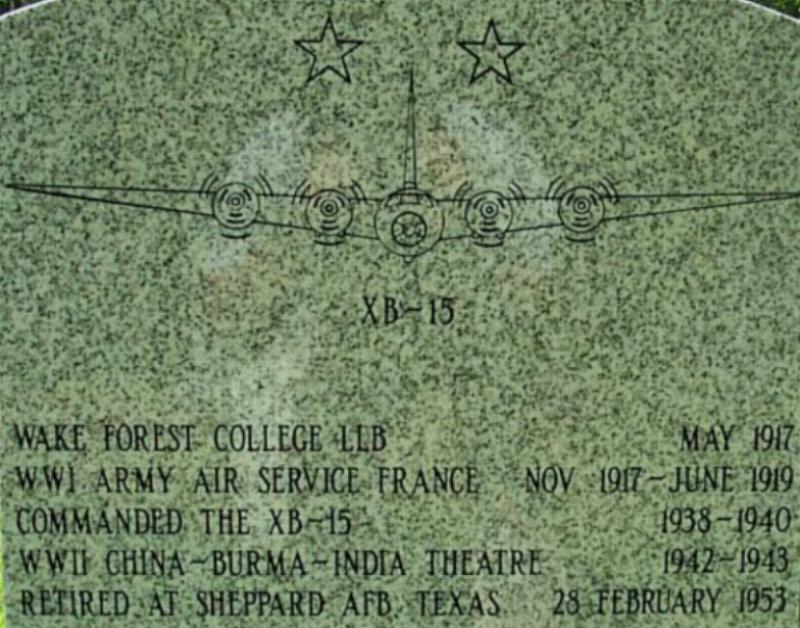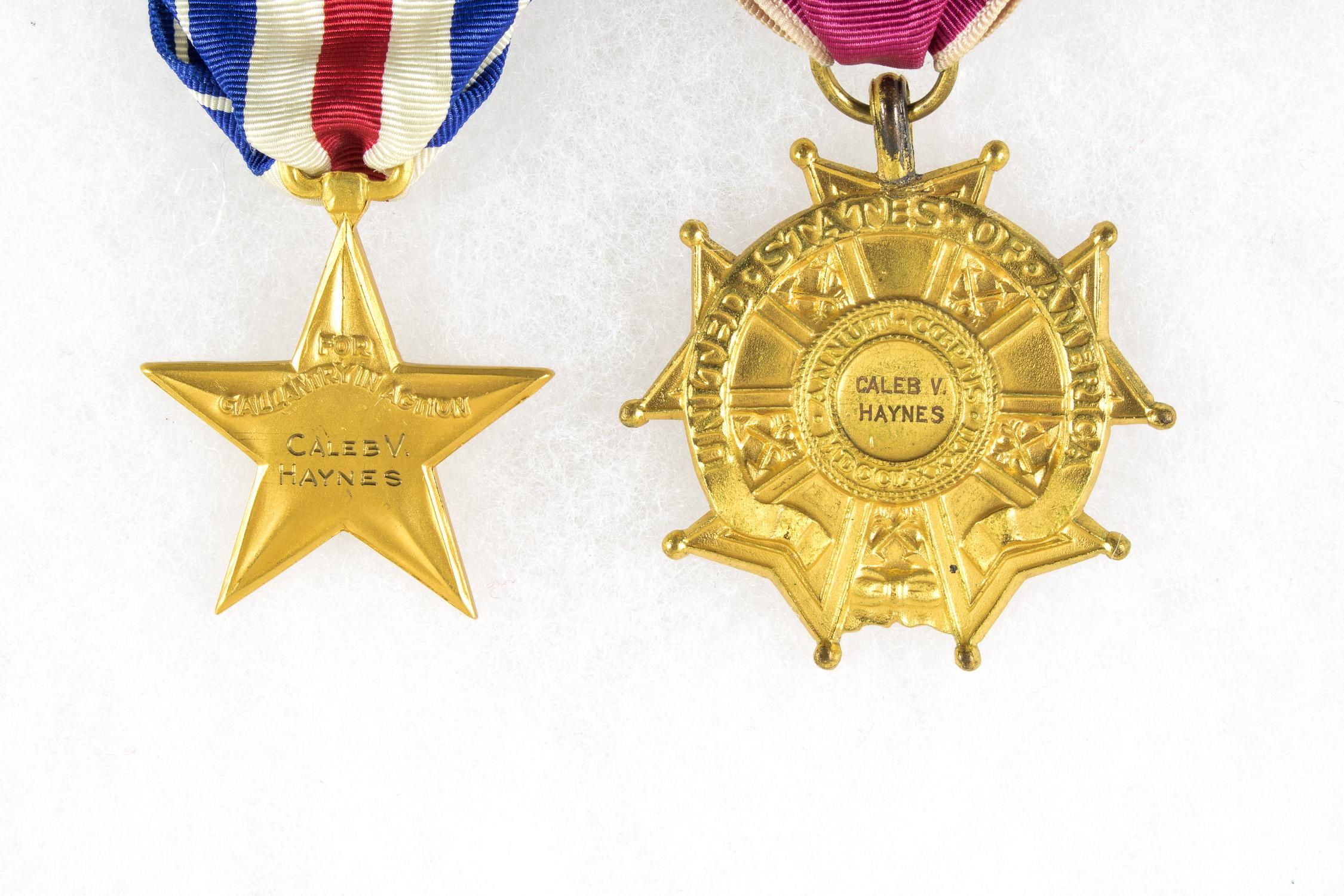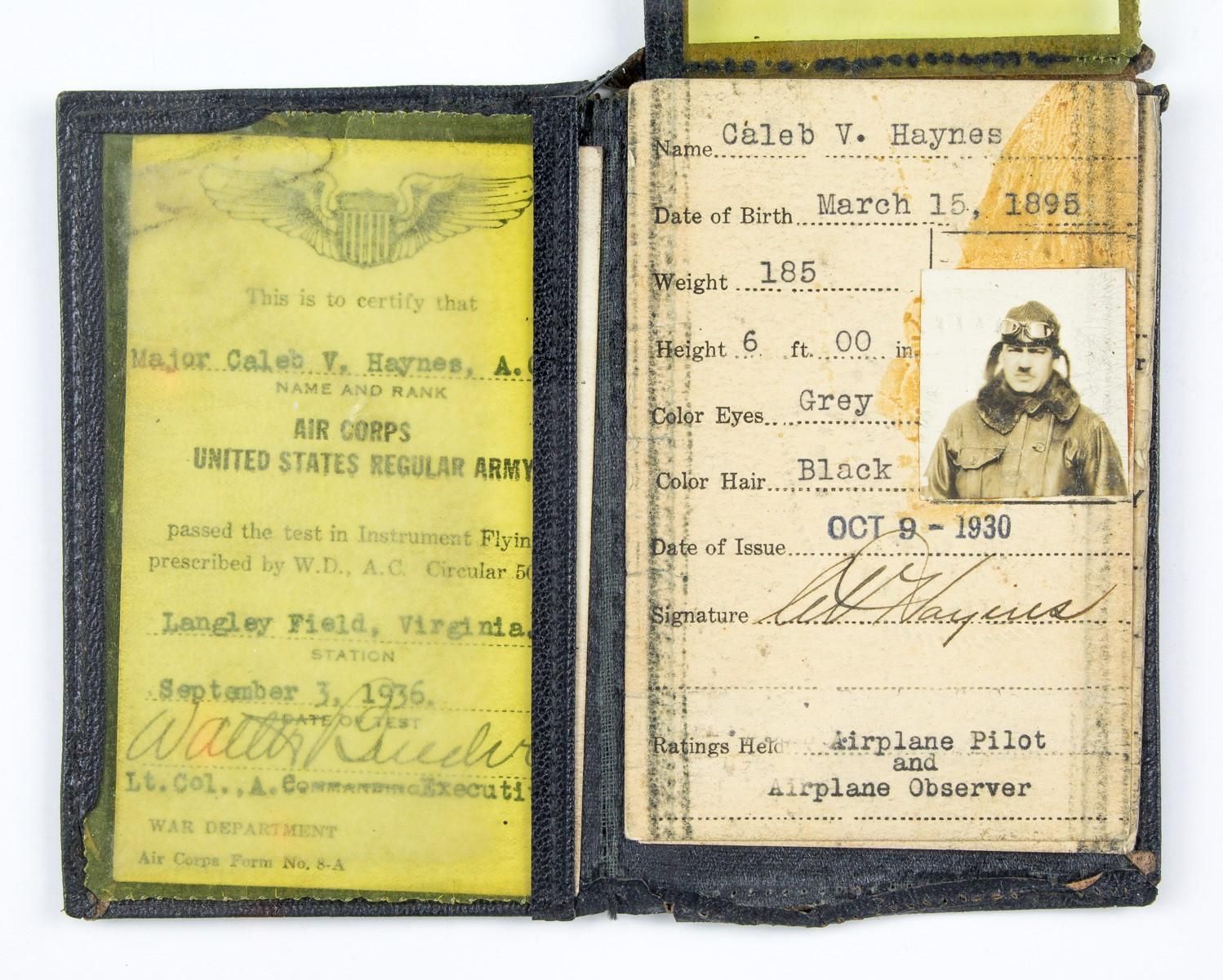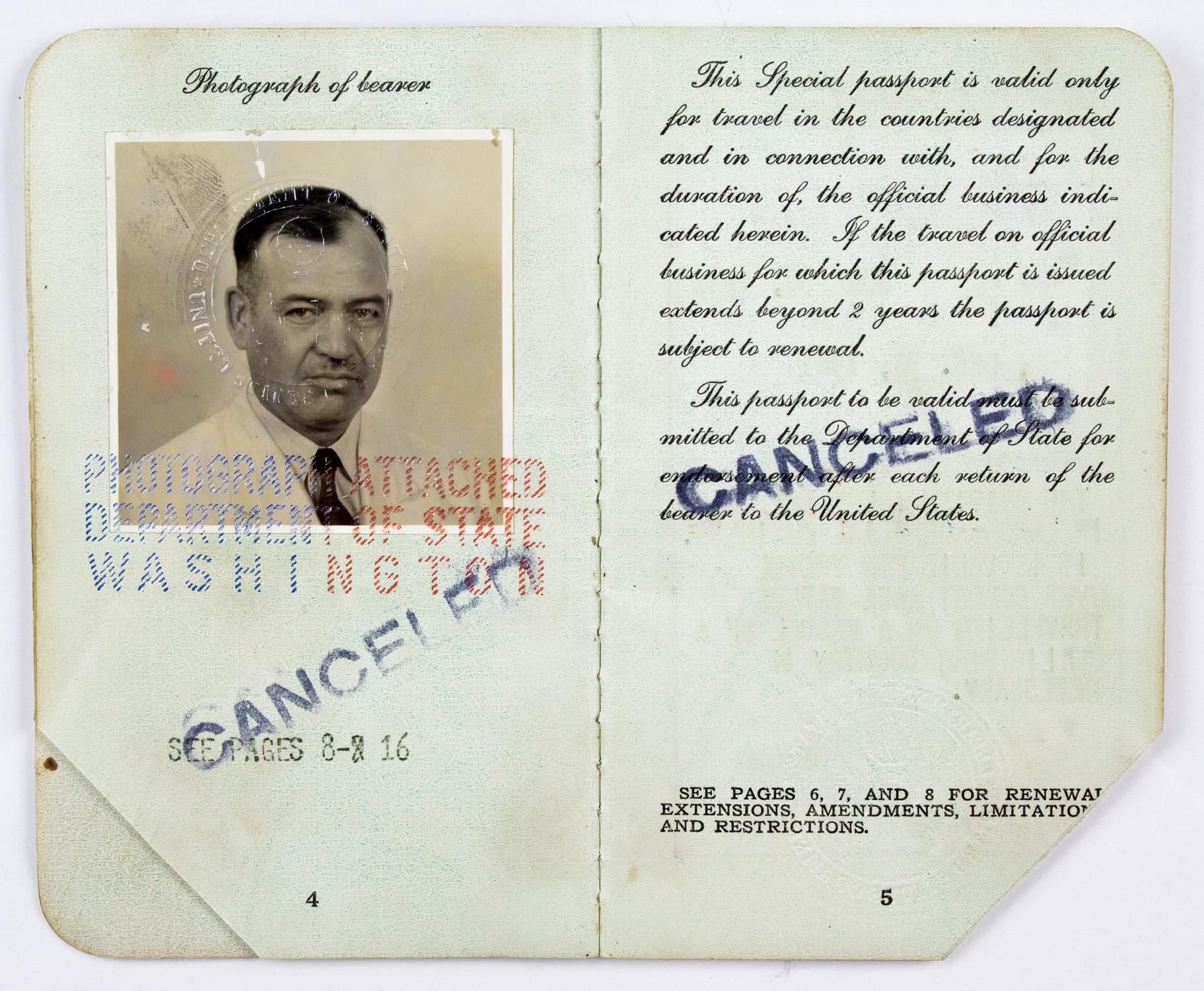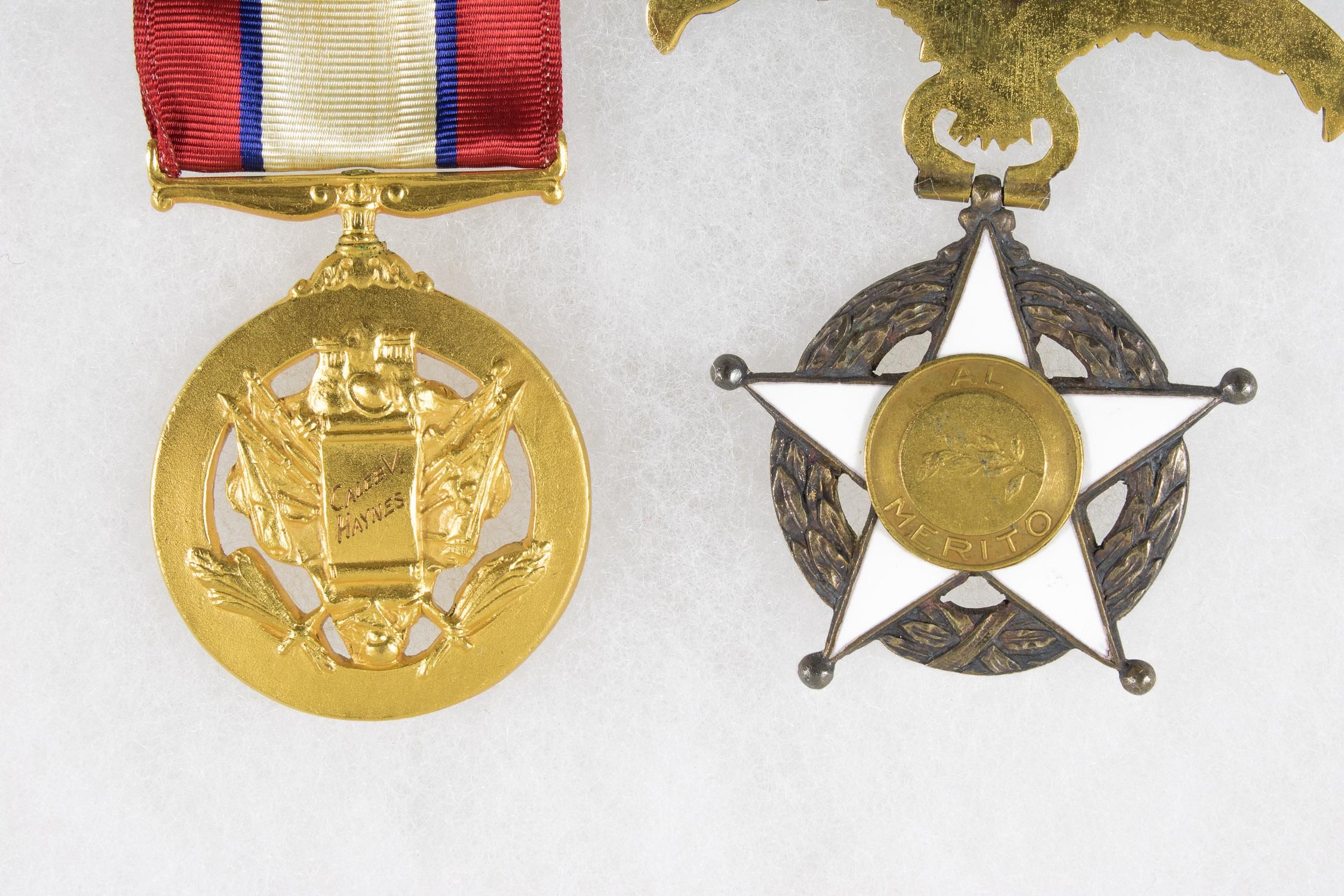(From official USAF biography, 1951)
Caleb Vance Haynes, Air Force veteran of both World Wars, and holder of ten military awards, was born at Mount Airy, N.C., in 1895. He graduated from Wake Forest College, N.C., in 1917 with a bachelor of laws degree, and a few months later entered the Army as a flying cadet.
From August to November 1917, he attended the School of Military Aeronautics at Georgia Polytechnic Institute, after which he sailed for France. He served at St. Maxient until the following March and then entered the Machine Gun School at Gondrecourt. In May 1918, he was commissioned a temporary second lieutenant in the Air Service, and sent to Tours as a test pilot. In July of that year he became an instructor at the Second Aviation Instructor Center at Issoudun and the following September was transferred to Orly as a test pilot. After the Armistice in November, he served as an aide to President Woodrow Wilson during the peace conference.
Returning to the United States in June 1919, he was assigned to Mitchel Field, N.Y. The following August he went to Speedway, Ind., for duty as supply officer of the Aviation Repair Depot. In July 1920, he was commissioned a second lieutenant in the Air Service of the Regular Army and in September became a test officer at the Fairfield, Ohio, Air Intermediate Depot. In May 1922, he went to Washington, D.C., where he served as officer-in-charge of gasoline and oil supply systems in the Office of the Chief of Air Service. In 1923, he piloted one of the six Army planes that flew from the United States to San Juan, Puerto Rico, on a goodwill tour.
He was ordered to Crissy Field, Calif., in August 1924, and transferred to Camp Lewis, Wash., the following June where he served three months as commanding officer of the Air Corps detachment. In September 1925, he returned to Crissy Field. He became an instructor and commanding officer of the 41st Division of the Washington National Guard, with station at Parkwater, Wash., in March 1927, and entered the Air Corps Tactical School at Maxwell Field, Ala., in August 1931.
Following graduation from the school in June 1932, he went to Langley Field, Va., for duty as engineering officer of the Eighth Pursuit Group. In February 1934, he assumed command of the Second Station, Eastern Zone, for the Army Air Corps mail operations with station at Bolling Field, D.C. From July 1934, until January 1935, was the commanding officer of the 37th Pursuit Squadron at Langley Field.
He then went to Rockwell Field, Calif., for special training in air navigation and instrument flying. Returning to Langley field in March 1935, he was appointed commanding officer of the 37th Attack Squadron at that station. He entered the Command and General Staff School at Fort Leavenworth, Kan., in August 1935, and graduated the following June. He then returned to Langley Field, where he served as commanding officer of the 49th Bombardment Squadron.
In February 1938, he participated in the Army flight from Langley Field to Buenos Aires, Argentina and in August of that year took part in the Army flight to Columbia.
The following January he returned to the Air Corps Tactical School at Maxwell Field to take a month's course in Naval Operations.
He won the Mackey Trophy for a trip to Santiago, Chile, in the XB-15 in 1939. In July of that year he received certificates issued by the National Aeronautics Association in connection with the establishment of an international record for the "the greatest payload carried to an altitude of 2,000 meters at Fairfield, Ohio. The following month he received certificates from the NAA for the establishment of an international 5,000 kilometer speed record with a 2,000 kilogram payload. The latter performance also established a national (U.S.) closed circuit distance record of 3,129.241 miles.
In February 1940, he was named commanding officer of the 41st Reconnaissance Squadron at Langley Field and from October to December 1940, was an aide to Brigadier General Arnold N. Krogstad at that station. He then became training adviser of the 13th Composite Wing at Borinquen Field, Puerto Rico.
From April to November 1941, he was in command of a bomb group at Borinquen Field and at that time organized the Puerto Rico Sector of the Sixth Bomber Command. In December 1941, he was made base commander of Borinquen Field. The following February he returned to Washington, D.C., to organize Force Aguila of the Halpro Project.
In April 1942 he went to India, where he organized the Assam-Burma-China Ferry Command, the organization that carried out the aerial evacuation of Burma in conjunction with the Chinese National Aviation Corporation and the Royal Air Force. In June of that year he went to China to organize and command the Bomber Command of the China Air Task Force under General Chennault. The following October he returned to India where he organized and commanded the India Air Task Force of the Tenth Air Force under General Clayton Bissell. He then returned to Assam in June 1943, to organize the American Air Command Number One, which he commanded until September 1943, when he returned to the United States.
In October of that year he became commanding general of the First Bomber Command at Mitchel Field, N.Y. In July 1944, he went to MacDill Field, Fla., where he took over the Third Bomber Command. In December 1945, he was assigned to headquarters of the Atlantic Division of Air Transport Command at Fort Totten, N.Y., and the following month was appointed commanding general of the Newfoundland Base command at Fort Pepperell, Newfoundland.
In July 1949, General Haynes became inspector general, Military Air Transport Service at Andrews Air Force Base, Md. He was appointed deputy commander for services of Military Air Transport Service two month later. In January 1951, he assumed command of the 3750th Technical Training Wing at Sheppard Air Force Base, Wichita Falls, Texas.
General Haynes has been awarded the Distinguished Service Medal, the Silver Star with oak leaf cluster, the Distinguished Flying Cross with two oak leaf clusters, the Air Medal with oak leaf cluster, and the Commendation Ribbon with cluster.
He is rated a command pilot, combat observer and aircraft observer.
(Up to date as of January 1951)
(From official USAF biography, 1951)
Caleb Vance Haynes, Air Force veteran of both World Wars, and holder of ten military awards, was born at Mount Airy, N.C., in 1895. He graduated from Wake Forest College, N.C., in 1917 with a bachelor of laws degree, and a few months later entered the Army as a flying cadet.
From August to November 1917, he attended the School of Military Aeronautics at Georgia Polytechnic Institute, after which he sailed for France. He served at St. Maxient until the following March and then entered the Machine Gun School at Gondrecourt. In May 1918, he was commissioned a temporary second lieutenant in the Air Service, and sent to Tours as a test pilot. In July of that year he became an instructor at the Second Aviation Instructor Center at Issoudun and the following September was transferred to Orly as a test pilot. After the Armistice in November, he served as an aide to President Woodrow Wilson during the peace conference.
Returning to the United States in June 1919, he was assigned to Mitchel Field, N.Y. The following August he went to Speedway, Ind., for duty as supply officer of the Aviation Repair Depot. In July 1920, he was commissioned a second lieutenant in the Air Service of the Regular Army and in September became a test officer at the Fairfield, Ohio, Air Intermediate Depot. In May 1922, he went to Washington, D.C., where he served as officer-in-charge of gasoline and oil supply systems in the Office of the Chief of Air Service. In 1923, he piloted one of the six Army planes that flew from the United States to San Juan, Puerto Rico, on a goodwill tour.
He was ordered to Crissy Field, Calif., in August 1924, and transferred to Camp Lewis, Wash., the following June where he served three months as commanding officer of the Air Corps detachment. In September 1925, he returned to Crissy Field. He became an instructor and commanding officer of the 41st Division of the Washington National Guard, with station at Parkwater, Wash., in March 1927, and entered the Air Corps Tactical School at Maxwell Field, Ala., in August 1931.
Following graduation from the school in June 1932, he went to Langley Field, Va., for duty as engineering officer of the Eighth Pursuit Group. In February 1934, he assumed command of the Second Station, Eastern Zone, for the Army Air Corps mail operations with station at Bolling Field, D.C. From July 1934, until January 1935, was the commanding officer of the 37th Pursuit Squadron at Langley Field.
He then went to Rockwell Field, Calif., for special training in air navigation and instrument flying. Returning to Langley field in March 1935, he was appointed commanding officer of the 37th Attack Squadron at that station. He entered the Command and General Staff School at Fort Leavenworth, Kan., in August 1935, and graduated the following June. He then returned to Langley Field, where he served as commanding officer of the 49th Bombardment Squadron.
In February 1938, he participated in the Army flight from Langley Field to Buenos Aires, Argentina and in August of that year took part in the Army flight to Columbia.
The following January he returned to the Air Corps Tactical School at Maxwell Field to take a month's course in Naval Operations.
He won the Mackey Trophy for a trip to Santiago, Chile, in the XB-15 in 1939. In July of that year he received certificates issued by the National Aeronautics Association in connection with the establishment of an international record for the "the greatest payload carried to an altitude of 2,000 meters at Fairfield, Ohio. The following month he received certificates from the NAA for the establishment of an international 5,000 kilometer speed record with a 2,000 kilogram payload. The latter performance also established a national (U.S.) closed circuit distance record of 3,129.241 miles.
In February 1940, he was named commanding officer of the 41st Reconnaissance Squadron at Langley Field and from October to December 1940, was an aide to Brigadier General Arnold N. Krogstad at that station. He then became training adviser of the 13th Composite Wing at Borinquen Field, Puerto Rico.
From April to November 1941, he was in command of a bomb group at Borinquen Field and at that time organized the Puerto Rico Sector of the Sixth Bomber Command. In December 1941, he was made base commander of Borinquen Field. The following February he returned to Washington, D.C., to organize Force Aguila of the Halpro Project.
In April 1942 he went to India, where he organized the Assam-Burma-China Ferry Command, the organization that carried out the aerial evacuation of Burma in conjunction with the Chinese National Aviation Corporation and the Royal Air Force. In June of that year he went to China to organize and command the Bomber Command of the China Air Task Force under General Chennault. The following October he returned to India where he organized and commanded the India Air Task Force of the Tenth Air Force under General Clayton Bissell. He then returned to Assam in June 1943, to organize the American Air Command Number One, which he commanded until September 1943, when he returned to the United States.
In October of that year he became commanding general of the First Bomber Command at Mitchel Field, N.Y. In July 1944, he went to MacDill Field, Fla., where he took over the Third Bomber Command. In December 1945, he was assigned to headquarters of the Atlantic Division of Air Transport Command at Fort Totten, N.Y., and the following month was appointed commanding general of the Newfoundland Base command at Fort Pepperell, Newfoundland.
In July 1949, General Haynes became inspector general, Military Air Transport Service at Andrews Air Force Base, Md. He was appointed deputy commander for services of Military Air Transport Service two month later. In January 1951, he assumed command of the 3750th Technical Training Wing at Sheppard Air Force Base, Wichita Falls, Texas.
General Haynes has been awarded the Distinguished Service Medal, the Silver Star with oak leaf cluster, the Distinguished Flying Cross with two oak leaf clusters, the Air Medal with oak leaf cluster, and the Commendation Ribbon with cluster.
He is rated a command pilot, combat observer and aircraft observer.
(Up to date as of January 1951)
Family Members
-
Minnie Ruth Haynes Avera
1890–1919
-
![]()
Joseph Bunker Haynes
1891–1964
-
![]()
Grace Adelaide Haynes Hill
1893–1978
-
![]()
Rachel Elizabeth Haynes Duffield
1897–1969
-
![]()
Margaret Lucile Haynes
1898–1990
-
![]()
Ethel Marie Haynes Ashby
1901–1982
-
![]()
Charles Davis Haynes
1903–1978
-
![]()
Lester Yates Haynes
1904–1966
-
![]()
Mary Louise Haynes McMaster
1906–1999
Sponsored by Ancestry
Advertisement
Explore more
Sponsored by Ancestry
Advertisement












